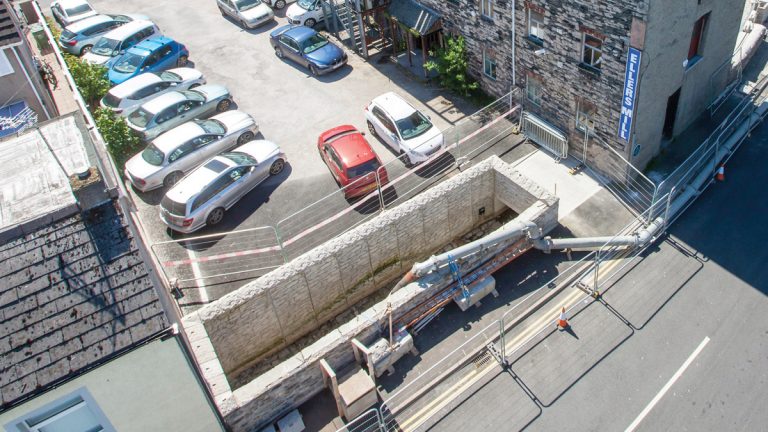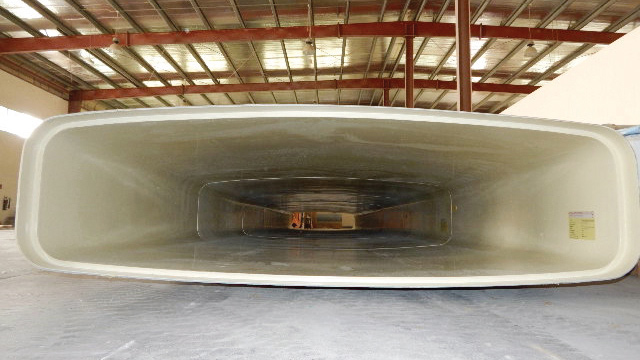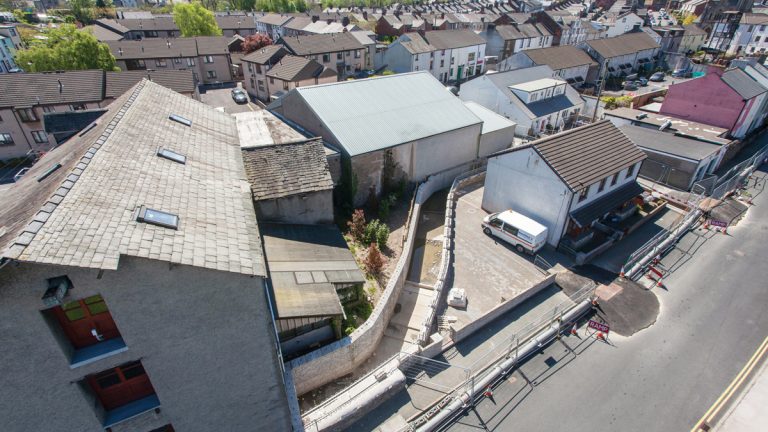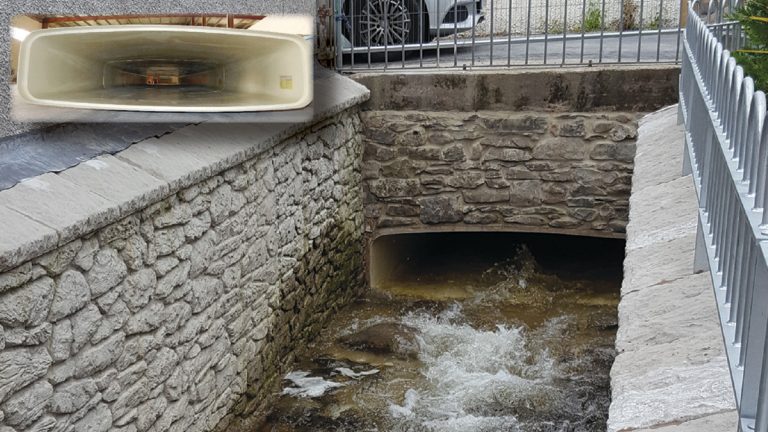Town Beck (Ulverston) Flood Alleviation Scheme (2017)

Chapel Street and the Ulverston skyline - Courtesy of JBA Bentley Ltd
Centrally positioned within the South Lakeland peninsula and on the border of the Lake District National Park, Ulverston is a busy Cumbrian market town with a population of around 12,000 people. The town is arguably most famous as being the birthplace of Stan Laurel, one half of the legendary comedy duo ‘Laurel & Hardy’, to whom there is actually a dedicated museum in the town – but it has gained increasing media exposure due to frequent and often substantial fluvial flooding. There have been ten significant flood events recorded since 1890, with the most recent event in 2009 causing flooding to 109 properties and businesses in the town.
Developing a scheme
The Environment Agency (EA) has been working in earnest to develop a scheme to alleviate flooding in the area for nearly a decade. The scheme has only been made viable by obtaining significant contributions from Cumbria County Council, Network Rail and South Lakeland District Council and by gaining local support to removing some significant blockers.
In 2015, The Environment Agency gained approval for a flood alleviation scheme, to provide a 1 in a 100 year standard of protection (protection against an event with a 1% annual exceedance probability) to 407 residential properties and 118 commercial businesses, including critical infrastructure. The scheme was quickly awarded for construction to contractors JBA Bentley Ltd and the works started on site in August 2015.
Background
The Town Beck watercourse has a small but steep and flashy catchment that drains the neighbouring Lakeland Fells, and passes water through the town centre and on to Morecambe Bay. Within Ulverston town centre the beck has been significantly influenced by human activity, with the channel artificially straightened, impounded between masonry walls and extensively culverted over. The watercourse through this area has nearly 50 riparian owners and is, in some sections, 150 years old.
The flood alleviation scheme is diverse in nature and includes raising of the existing linear defences to contain floodwater on open channel sections and the refurbishment and replacement of long culverted sections which run underneath commercial and residential buildings through the town centre. The culvert is heavily littered with service crossings and uncharted cross connections.
The scheme also includes for replacement of an archaic culvert structure which runs through an operational rail embankment at the southern edge of the town.
Delivery
The majority of the scheme is being delivered using the Environment Agency’s Water and Environment Management Framework with JBA Bentley, a joint venture between JBA Consulting Ltd and JN Bentley Ltd, responsible for constructing approximately £6.1m of flood defence work designed in part by Atkins and supplemented by additional contractor-led design works. A second contract is in place between the EA and Network Rail to design and construct the new rail culvert which is being built in tandem with the main scheme.

Raised defences at ‘The Ellers’ constructed from precast reinforced concrete with stone cladding – Courtesy of JBA Bentley
Linear defences
Within Ulverston there are a series of open channel sections that have historically overtopped and flooded the town at lower return periods. These areas are being raised to defend against the 1% AEP flood event. This has been achieved using a combination of precast and in situ reinforced concrete walls, with a stone cladding and/or textured formwork liners.
Ideally, all the wall-raising works would have been completed using precast concrete units, but the constrained nature of urban working meant that this was simply not practical in some locations.
Where the working area was especially restricted, for example at ‘The Gill’, JBA Bentley could not dismantle the original flood walls without first excavating behind the walls and creating a new temporary mass concrete working platform to support the construction plant. Whilst this slowed the initial construction process, it did have a benefit of improving the wall backfill properties and meant avoiding digging out the previously-required shear key at the toe of the wall; arguably the trickiest aspect of the wall build due to its depth and proximity to adjacent structures.
These works, all of which are in a conservation area, were completed in close liaison with local planning officer and include a new trash screen and telemetry system to improve flood warning information in the local area.
Culvert refurbishment
Extensive culverting of the watercourse has taken place incrementally over many years, with some sections originating from the early 1900s. As a result, the culvert has numerous construction forms, shapes and sizes making refurbishment work and hydraulic modelling much more complicated.
The culverts pass under many of the main roads within the town centre and were in particularly poor condition. The road sections were generally rectangular in form and had been constructed from old railway lines (beams) supporting a deck comprising thick stone slabs. This type of construction, i.e. utilising uncontrolled natural building materials, is virtually impossible to assess quantitively. Thus, the soffits were earmarked for replacement by the schemes original designers.
Unsurprisingly, given the urban setting, the roads contain many of the town’s major services. The cost of diverting these services to allow replacement of the culvert soffit was extremely high. In a bid to avoid service interaction, the usual lining options (UV, thermal cured) were considered but ruled out due to the rectangular shape of the culvert, and the need to maximise the hydraulic capacity of the culvert. Fortunately, since the original design work was completed (2011), lining techniques have continued to develop.
Glass reinforced plastic (GRP) segmental units, can now be formed to meet almost any size, shape or load requirement. This is achieved by simply manipulating the thickness of the unit walls. The product is built up by applying layers of GRP tape to a mould and has a very low hydraulic roughness which easily compensates for any reduction in hydraulic cross section. This flexibility has led to a growing market within Europe.

Glass reinforced plastic (GRP) liner units that have been installed within the Town Beck culvert – Courtesy of JBA Bentley Ltd
The liners are rigid and we took advantage of 3D laser scanning techniques and Revit models to ensure they fitted within the culvert. The units were then validated with more traditional man-entry surveys and a plywood template.
This repair technique shortened the construction programme by 10 weeks and allowed us to repair the culvert beneath busy roads and residential properties with minimal disruption. We avoided closing roads, demolishing and rebuilding three residential buildings, and over £125,000 of major service diversions.
Culvert replacement
The original culvert repair schedule was first compiled in 2013, but by the time JBA Bentley entered Brewery Street car park in March 2015, the culvert condition had deteriorated to a critical state and it was immediately apparent that several areas of the car park were unsafe.
The critical area of concern was a dry-stone masonry arch which had buckled and bellied such that it could no longer be considered to act fully in compression; a precarious position for an arch structure. JBA Bentley, the Environment Agency and South Lakeland District Council quickly coordinated to cordon off the worst affected areas and install a temporary weight restriction to the remaining car park until it could be repaired.
Over the next six weeks the team undertook an expedited optioneering appraisal, costed various repair/replacement options and ultimately agreed funding for a full replacement solution. Due to uncertainties associated with ground conditions and buried services an online solution was progressed which utilised precast box culvert units with in situ reinforced concrete tie-ins. This solution was preferable because it offered the reduced procurement associated with standard units, whilst maintaining the expedited installation programme that is achieved by utilising precast construction. The agreed solution had to be fully designed, procured and installed before the famous annual Dickensian Festival held each November.
The culvert replacement instruction was issued in May 2015, and site works commenced eight weeks later in July. The most challenging aspect of the design involved incorporation of the existing arch structure into the replacement, i.e. the tie-in points.
The culvert being a drystone masonry arch construction at the upstream tie-in made the connection a particularly awkward detail. Prior to demolishing the defective areas of arch culvert, a plan had to be formulated to ensure the integrity of the adjacent arch where it was to be retained. To do this the site team carefully exposed the arch barrel from above and saddled it with concrete. This approach ‘knits’ the individual voussoirs of the barrel together and ultimately stops a progressive failure when any adjacent masonry is taken out of compression, i.e. during the demolition process.
Internally hydraulic transitions were incorporated into the structure to reduce the energy losses that would otherwise occur when the culvert changes shape. This was managed by using strategically positioned tapers and managed level changes within the new culvert.

Curved profile of the linear defences at ‘The Ellers’ and complex interaction with adjacent buildings – Courtesy of JBA Bentley Ltd
Removing the hydraulic ‘bottle neck’
In May 2017, a new 1.8m diameter reinforced concrete culvert was installed via pipe jacking technique. The culvert is designed to intercept overland flow as it spills from Town Beck and transfer it to the south side of the railway into the wider floodplain.
On the south side of the railway a new flood defence embankment and swale feature will be installed to prevent outflanking of the defences and to formalise a connection between the new rail culvert and the Town Beck.
Although this new culvert will only be operational in flood conditions, the swale will provide an important means of draining run-off from the adjacent fields during periods of wet weather. Further to this, works will be undertaken to top-up a number of bunds protecting properties in the area and carry out works to ensure the longevity of the existing wall defences.
The Environment Agency is currently in the process of developing a business case to improve flood resilience in the south Ulverston area which has more complex flood mechanisms, including influences from another watercourse (Dragley Beck), surface water drainage and coastal flooding.

Completed glass reinforced plastic (GRP) liner installation – Courtesy of JBA Bentley Ltd
Conclusion
The design and build process has been challenging with numerous stakeholders and practical constraints emerging during the works, all of which have required the project team to respond to change using innovative and collaborate approaches to maintain momentum on site. This collaborative approach has delivered substantial approved and forecast efficiency savings and the scheme now ranks within the top ten nationally for the EA.
There are currently four active working areas within the scheme footprint and although busy, the overall construction programme is on track for the anticipated November 2017 completion date.
The Town Clerk for Ulverston, Jayne Kendall, recently wrote:
“Ulverston Town Council has been working closely with the Town Beck FAS project team to make sure that they and ourselves are fully up-to-speed with the timescales and scope of the work, and the effects that the work has on the Town. This has enabled the Town Council to communicate properly with the local councillors, local residents, and businesses in Ulverston to let them know what is happening during the construction of the scheme as well as the benefits of the scheme when completed. This has allowed us to work together to minimise the disruption caused by the construction work and reduced parking in the Town, and also allowed us to feed back any concerns and compliments to the project team. The relationship has been a true partnership approach, and has worked extremely well. The town council is extremely impressed with all of the team involved in this complex project and thanks them very much for their courtesy and efficiency.”





